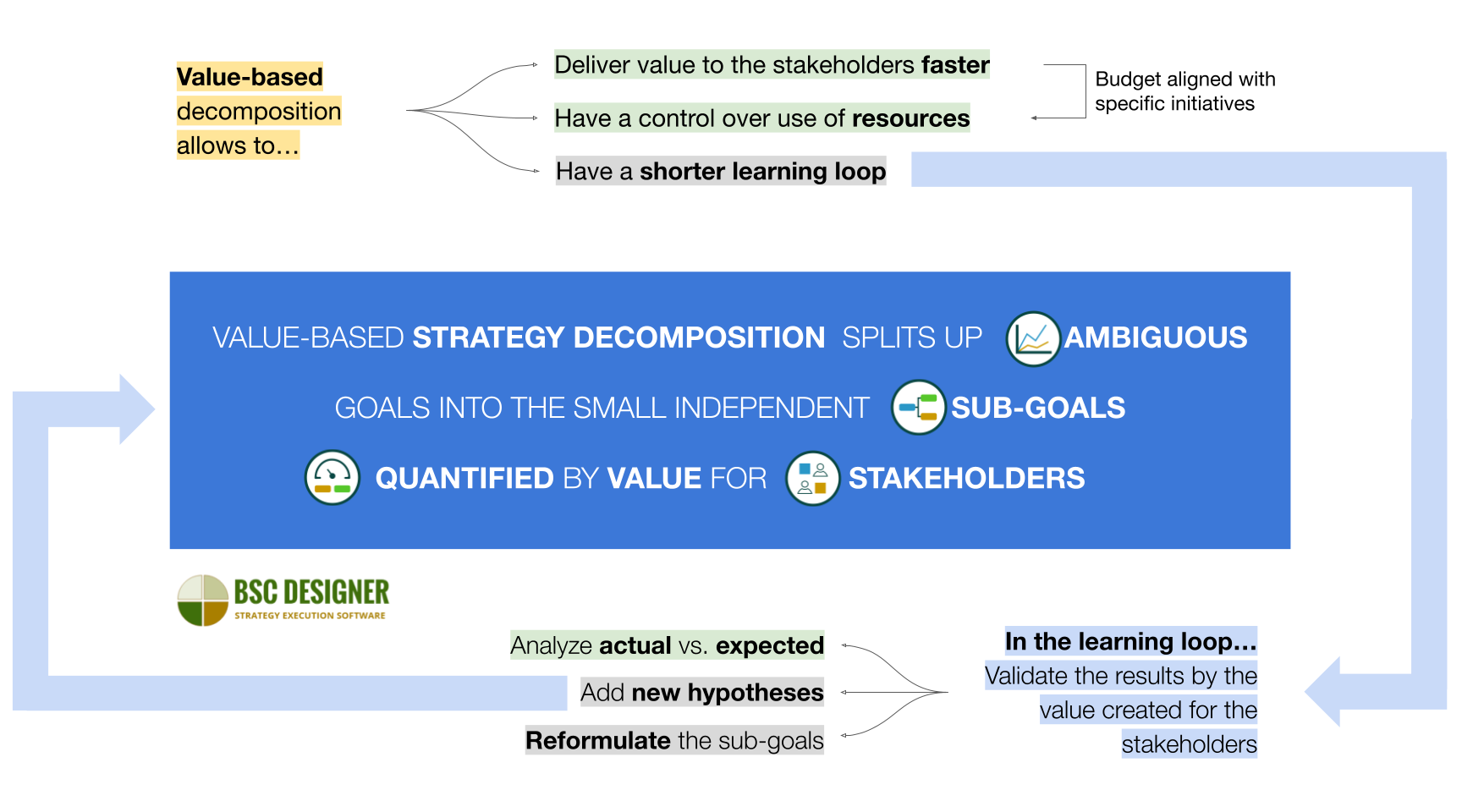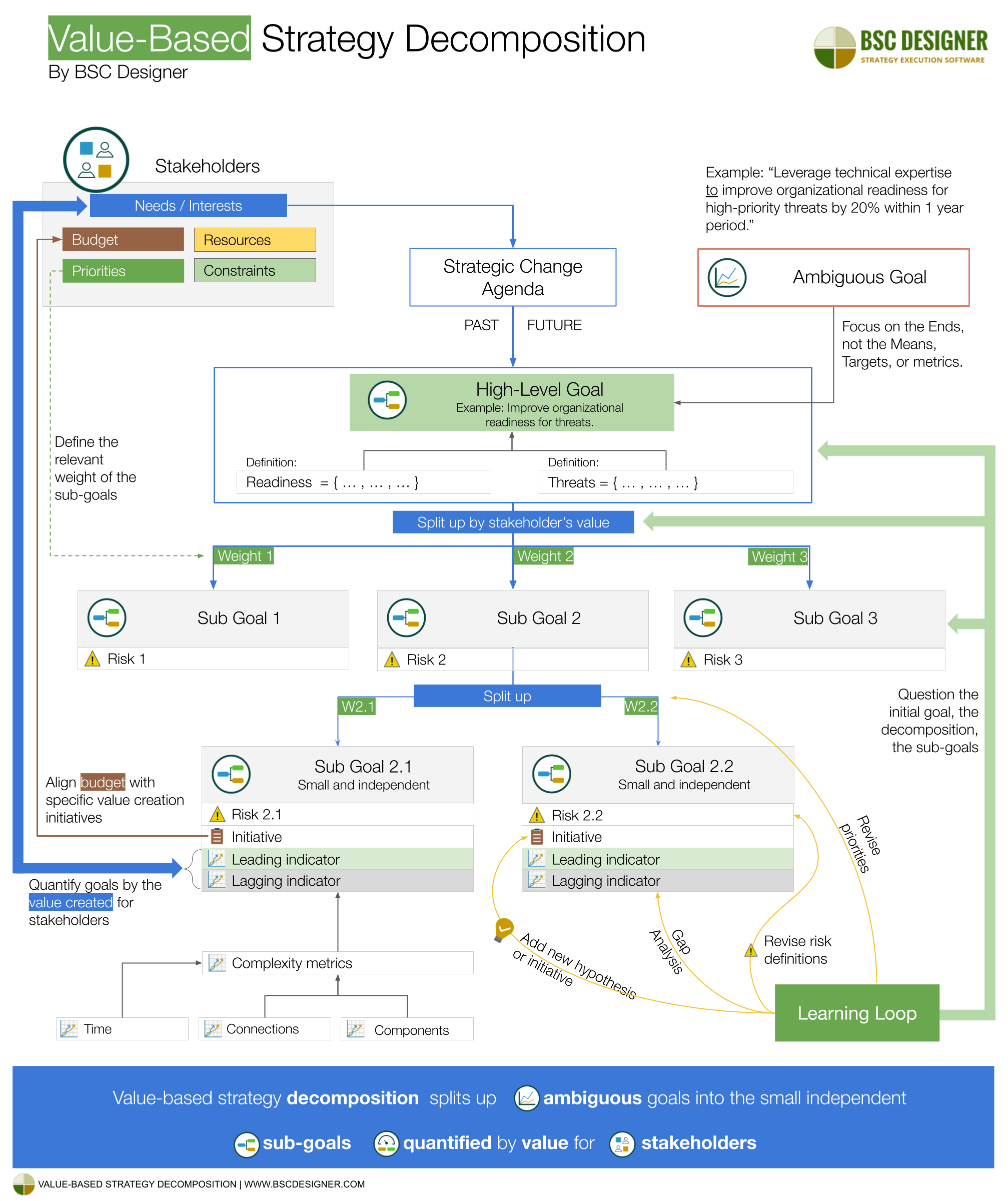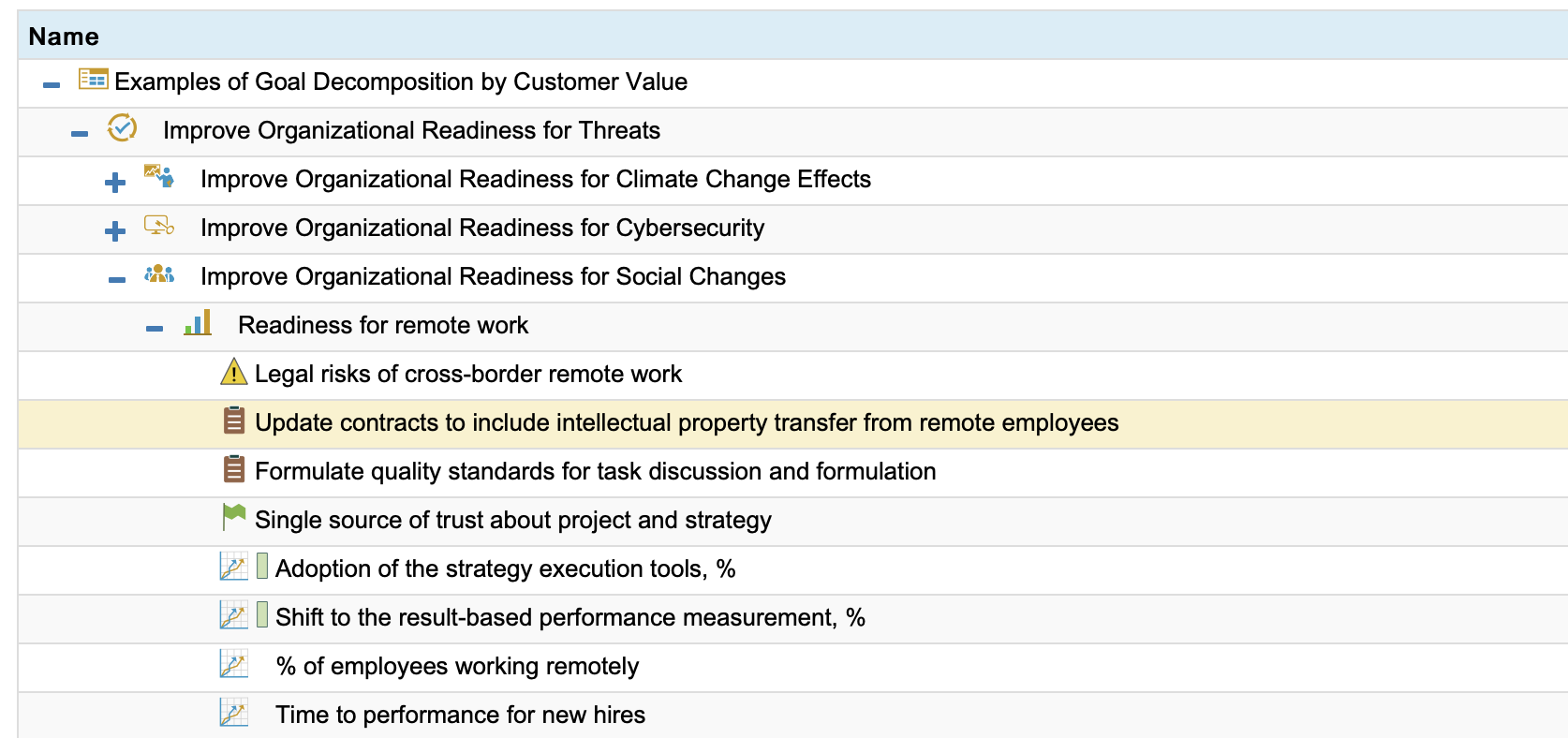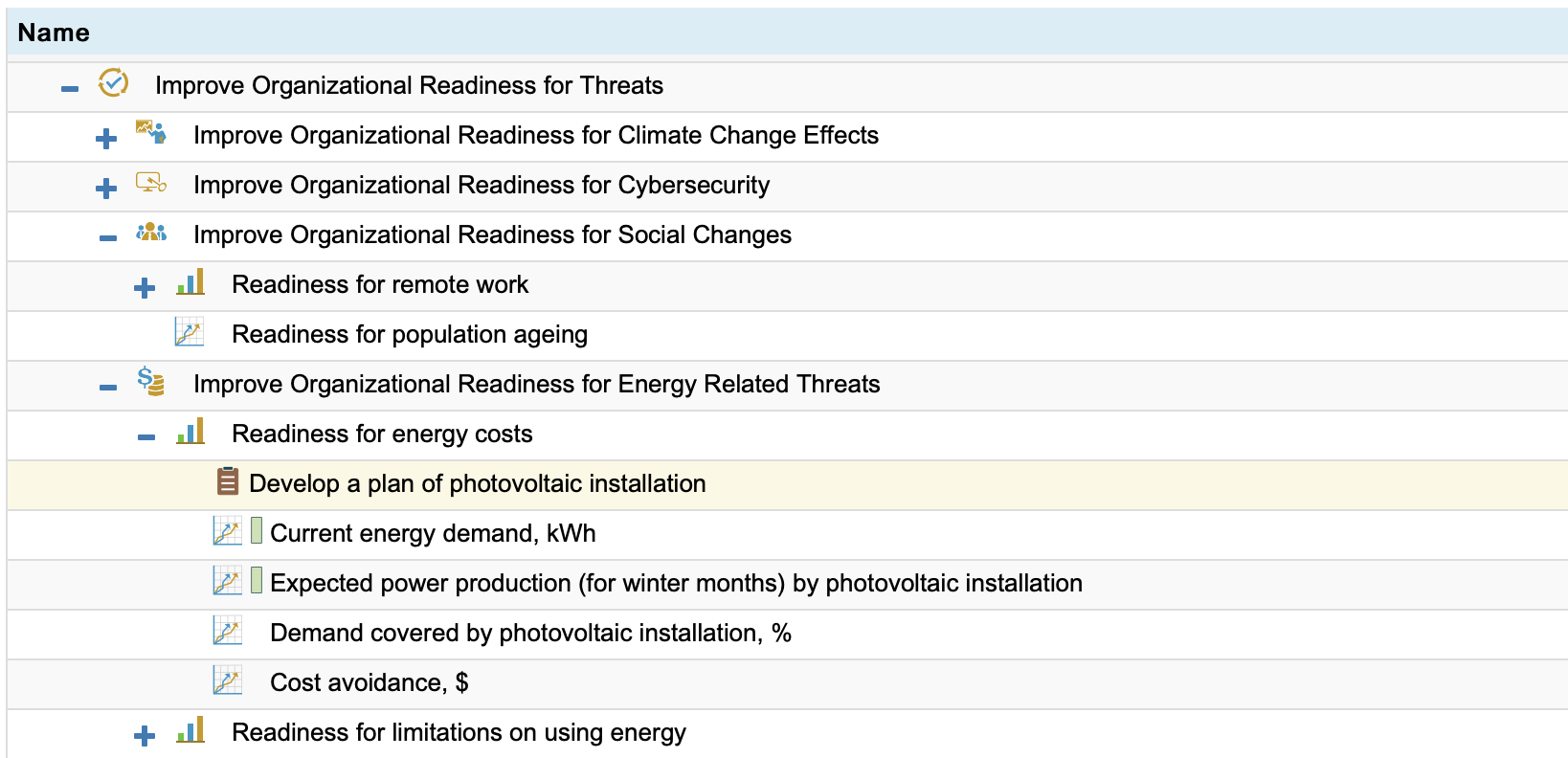Strategies fail because of vague and ambiguous goals. Learn how to break-down high-level strategies into specific, actionable sub-goals quantified by the value for stakeholders.

The Content:
- Introduction: strategy formulation challenges
- Strategy decomposition: general principles, preparation, decomposition by value
- Software automation: decomposition for users of BSC Designer
Introduction: What is a Success Rate of Strategy Execution?
A statistic that circulates over the Internet says that 63% to 87% of companies fail to execute their strategies. Let’s see if that’s true.
- The 87% figure looks to originate from the book Profit from the Core1. In the 1990s, authors surveyed 1,854 large corporations and found out that seven out of eight were not satisfied with “achievement of their financial targets.”
- In research2 by Marakon Associates, authors surveyed 197 organizations to find out that “companies on average deliver only 63% of the financial performance their strategies promise.”
Financial outcomes in isolation are not the best way to judge the success of strategy. It’s an exaggeration to say that all those strategies failed! Phil Jones explores in detail the origin of these misleading statistics3.
How many strategies fail? We don’t really know!
Here is one of the conclusions of the “Strategy implementation: What is the failure rate?” study4:
“The true rate of implementation failure remains to be determined. Most of the estimates presented in the literature are based on evidence that is outdated, fragmentary, fragile or just absent.”
Poorly Formulated Strategies are Hard to Communicate
Such strategies remain in the minds of top managers, while other employees are not aware about the strategy or don’t understand it.
- In the Marakon Associates survey, the factor of poorly formulated goals was attributed to 45% of the failures.
- The authors of the Balanced Scorecard framework, refer5 to their research, where “95% of a company’s employees are unaware of, or do not understand, its strategy.”
Does the Balanced Scorecard Framework Solve This Problem?
There are some frameworks like the K&N Balanced Scorecard that help with the strategy description6.
The problem is with the inputs for these frameworks!
In essence, any strategy framework operates with these quantums (building blocks):
- The Ends (goals, objectives, expected results…)
- The Means (action plans, initiatives, projects…)
- The Quantifications (the KPIs, indicators, metrics…)
To formulate a good strategy that creates value for the stakeholders and is easy to communicate, your strategy team needs to master all these three quantums:
- The means are well described in project management discipline.
- We already discussed the measurement part in detail.
- In this article, we’ll focus on the goals.
Decomposition of Ambiguous Goals
Words can be meaningless. If they are used in such a way that no sharp conclusions can be drawn.
Richard P. Feynman
There are three typical problems with strategy scorecards:
- Having vague or ambiguous goals
- No analysis of the stakeholders and their needs
- No alignment between the goals and the value created for the stakeholders
The solution is value-based strategy decomposition.


Value-Based Decomposition: General Principles
When working with clients of our strategy execution software, we explain strategy decomposition in this way:
Strategy decomposition splits up ambiguous goals into the small independent sub-goals quantified by value for stakeholders
Goal decomposition is a skill and an art! It sounds a lot like duality of strategy that Henry Mintzberg7 described as:
Strategic planning isn’t strategic thinking. One is analysis, and the other is synthesis.
Does goal decomposition help?
Empirical studies8 demonstrated that dealing with decomposed questions/goals is easier than dealing with an initial complex goal.
To prepare for the decomposition, we need to:
- Split up Ends, Means, Targets
- Understand the stakeholders and their needs
- Simplify the language used and define the terms
With conventional decomposition9, we can break down strategies by structure, goals, behaviors or combination of them.
In a case of value-based decomposition, we split up strategies by value for stakeholders into small and independent goals. This allows us to:
- Deliver value faster
- Have better control over resources
- Have a shorter learning loop
We stop decomposition when we:
- Get to the action level, and
- Can quantify the value for the stakeholders
In the learning loop, we:
- Review the gaps between expected results and actual achievements
- Reformulate the sub-goals if they are not aligned with stakeholder value
- Formulate new hypotheses
Prepare for Strategy Decomposition
Let’s discuss how these general principles apply in practice.
Split up Ends, Means, Targets
“The perfection of means and the confusion of ends seems to be our problem.”
— Albert Einstein
The major problem of strategy description are vague and ambiguous goals. Attempting to address this issue by employing SMART goals masks the underlying ambiguity problem.
Test for ambitious goals: ask two persons to explain the meaning of the goal, if you have two semantically different answers, then the goal is ambiguous.
Here you have an example of such goal:
- “Leverage technical expertise to improve organizational readiness for high-priority threats by 20% within 1 year period.”
Here we actually have:
- The goal – “Improve organizational readiness for threats“
- The target for readiness indicator – “by 20%”
- The time scope for the target – “within 1 year period”
- The mean to achieve the goal – “Leverage technical expertise”
The final goal might look good on annual plans, but it’s not suitable for someone to start working on it.
- Typically, targets like “improve by 20%” are pure aspirations – there is no analysis of the success factors or requirements of the stakeholders that support this number.
- The “1 year” timeframe is more about annual budget planning than about the goal.
- Including the mean (“Leverage technical expertise”) in the goal definition doesn’t help. Is this the best solution for this goal? What measurable outcomes do we expect?
Understand Stakeholders and Their Needs
In our example, the stakeholders can be:
- Management Team
- Employees = {IT Team, HR Team, Legal Team, New Hires}
- Customers
- Regulators
If you don’t have any goals yet, use the Strategic change agenda to formulate high-level goals of the stakeholders.
Simplify Language, Define the Terms
Simplify:
- “Leverage” => “Use”
- “Technical expertise” => everything is about expertise, when undefined, it doesn’t add value
- “High-priority threats” => define a scale of measurement for threat priorities or replace with just “threats”
The terms readiness and threats need to be defined. We need to answer the question:
- What does “readiness” mean for the stakeholders?
- What “threats” are important for the stakeholders?
Here are my examples:
- Readiness = {Analysis of the threat, Having prevention plan, Having response plan, Having recovery plan}
- Threat = {Climate change effects, Cybersecurity threats, Social change threats, Energy related threats}
I did the definitions of the terms right in the strategy scorecard that I use for this article:


If you are looking for a more formal way to describe the goals, consider using planning tools like Planguage10 by Tom Gilb.
The Re-Formulated Goal
We’ve reformulated the goal from:
- “Leverage technical expertise to improve organizational readiness by 20% for high-priority threats within 1 year period”
To
- “Improve Organizational Readiness for Threats”
And defined the concepts of “readiness” and “threats.”
Decomposition by Value is More Intuitive than Algorithmic
“If I had an hour to solve a problem, I’d spend 55 minutes thinking about the problem and 5 minutes thinking about solutions.” — Albert Einstein
I used BSC Designer software to describe the decomposition of the “Improve Organization Readiness for Threats” goal into subgoals. You can check out the results online.
Below, I illustrate with examples some general principles that work for us and our clients.
Value-Based Decomposition Wins Process-Based Decomposition
Think about learning a foreign language. A typical school program decomposes this goal by process – we start with basics of grammar, some vocabulary, some practice and then increase the level of difficulty. The value for the students is validated by exams that have little to do with real life situations.
This approach doesn’t allow students to capture the value fast enough. Most people find it out when practicing their language skills as a tourist.


In contrast, value-based decomposition is created around the cases that the student will face in the near future. Grammar and other things follow but don’t mandate the course of action. With the same resources invested, the value for the students is created much faster.
It means that a student stakeholder:
- Makes mistakes faster
- Finds blind spots faster
- Adjusts goals/requirements faster
- Finds a better way to get the value
That’s applicable to any domain, for example, Tesla does it for car design and manufacturing when introducing 20 engineering changes per week.
Decompose to the Level of Small Deliverable Sub-Goals
How to build a city on Mars? In the interview with Everyday Astronaut11, Elon Musk shared his decomposition (optimization):
- Fastest time for a city on Mars -> Fastest time to fully reusable rocket -> Fastest time to orbit -> … {Manufacturing Starships} -> {Many sub-goals that SpaceX is working on right now}
You might argue that manufacturing Starship is not a small goal. I do agree, Musk’s team still has to solve many engineering challenges, but they already solved an important one – the engine. Instead of building a huge engine for a 120 m rocket, they installed 33 small Raptor engines. Excellent example of problem decomposition!
Giving your team a goal “Improve Organizational Readiness for Threats” is like asking them to build a city on Mars. Some bright minds from your strategy team need to decompose the goal to the level of small deliverable sub-goals.
Decomposition of the Example Goal
If we combine “HR Team” and “New Hires” stakeholders in the context of one of the social threats (for example, “remote work”), we can formulate this decomposition:
- “Improve Organizational Readiness for Threats” -> “Improve Organizational Readiness for Social Threats” -> “Improve readiness for remote work”
At this level, we can formulate a risk:
- Legal risks of cross-border remote work
And this initiative:
- Update contracts to include a clause of intellectual property transfer from remote employees


The formulated initiatives are short-term – we’ve got to the action level with small deliverable parts. We are ready to start moving towards the city on Mars!
Small Sub-Goals Mean Better Control Over Budget
With small sub-goals, we have better control over the use of resources.
- Instead of pre-allocating the budget through the annual planning process, we will align the budget with specific value-creation initiatives.
The total budget is still there as a constraint defined by management/investor stakeholders.
Decompose into Independent Sub-Goals
Strictly speaking, everything is connected in the organization (like “Readiness for limitations on using energy” is related to the “Readiness for extreme weather”), but we’ll use the superposition principle, pretending that working on one goal doesn’t affect another goal.


In my decomposition tree, there is a branch “Readiness for energy costs,” where “energy costs” is a decomposition of the “energy related threats.” The initiative for that sub-goal is formulated as:
- Develop a plan of photovoltaic installation
We can work on this goal (“Readiness for energy costs”) and the goal from the previous example (“Improve readiness for remote work”) independently and simultaneously.


Moving Bottom-Up is Possible But is Generally a Bad Idea
The direction of the decomposition is not prescribed. Actually, what we discussed was based on deductive reasoning (moving from general to specific). We can also apply the inductive reasoning (moving from specific to general).
We could start with an interesting technology, find the sub-goal where it is useful and with inductive reasoning, get to the high-level goal that was not taken into consideration before.
- The challenge here is to focus on the real (as validated by value metrics) problems of stakeholders.
Many digital transformation efforts failed because technologies implemented were based on imaginary value for the stakeholders that was never validated in practice.
Decompose to the Level When You Can Quantify the Value for the Stakeholders
The fact of quantification of value for the stakeholders and assigning targets means that we have at least some basic understandings of how things work. A nice bonus is a possibility to measure the progress towards the goal.
Example “Readiness for Remote Work”
In the context of:
- Goal: Readiness for remote work
- Stakeholders: Management Team, New Hires, HR Team
We can quantify the value for the stakeholders (Management Team) with this lagging metric from the Talent scorecard:
- Time to performance for new hires
“HR Team” and “New Hires” stakeholders are interested in understanding how exactly those results can be achieved. The value for them can be quantified with these leading indicators (leading vs. lagging indicators – what’s the difference?):
- Adoption of the strategy execution tools, %
- Shift to the result-based performance measurement, %


These leading indicators make more sense in the context of specific initiatives. For example, “Shift to the result-based performance measurement, %” can be an indicator of the “Single source of trust about project and strategy” initiative.


Example “Readiness for energy costs”
Another example is “Readiness for energy costs.” We can say that we have passed the analysis phase when we have data for these two leading indicators:
- Current energy demand, kWh
- Expected power production (for winter months) by photovoltaic installation


For the Management Team, the important value quantification can be via these lagging indicators:
- Demand covered by photovoltaic installation, %
- Cost avoidance, $
More examples of quantification by value
- Quality
- Leadership effectiveness
- Creative process (graphic designer)
- Cybersecurity
- Remote work
Understand the Priorities of the Stakeholders
While the stakeholders have many needs, your resources are limited. It’s important to understand the priorities of the stakeholders and capture them when decomposing into subgoals.


My recommendation is:
- Formulate and test hypotheses, get real-life data first.
- When there is enough data, specify the relevant weight of the alternatives (see the automation chapter)
- The relevant weight can be assigned intuitively or calculated using one of the prioritization frameworks.
Complexity Metrics are Good Proxies of Value Metrics
Sometimes, the sub-goal looks promising, but it’s hard to find any good (=inexpensive to measure) metric for the stakeholders’ value.
Here is my personal case: when planning the installation of security cameras in our house, we could decompose the idea of “security” into tangible risks and their probabilities, but as it was a personal project, we formulated the reasoning as “just for a case.”
From the view point of complexity12, “just for a case” means that:
- The complexity of installing a few cameras is less than the complexity of hiring someone to check out the property regularly.
When we were on holiday, an extreme weather event hit the Canary islands. One of the cameras detected movement, and I received a picture of terrace furniture thrown by the wind towards the public road on my smartphone. We found a person who could go there and recover the furniture.
- That day, the value of the security cameras became more tangible.
Learning Loop
We are trying to prove ourselves wrong as quickly as possible because only in that way can we find progress.
Richard P. Feynman
Use the quantified value for the stakeholders to improve the goal decomposition:
- Find the gaps between expected results and actual achievements – analyze the root cause.
- Revise metrics and the behavior they induced, update them to better capture the value for the stakeholders.
- Add new sub-goals to the decomposition tree (adding branches or adding levels).
- Explore connections between previously independent goals.
- The decomposition might not be the optimal one, so reformulate sub-goals according to the new perception of the value for the stakeholders.
- The initial goal might be wrong – question the initial goal.
Software for Goals Decomposition
In this article, I’ve used the BSC Designer software to automate the goal decomposition. You can check out the final results in this scorecard.
If you plan to do goal decomposition with BSC Designer, you will find these productivity hacks useful.
Initial Setup


Switch to the Decomposition profile for the KPIs tab (Tools > Columns) to display the columns essential for the goal decomposition:
- The goals, indicators, initiatives
- Initiatives
- Weight column for relevant importance of the sub-goals
- Measure column for measurement units of indicators
- Stakeholders’ column (adjust stakeholders via Settings > Strategy)
- Count column to have an idea about the number of sub-items
Decomposition of the Goals


To create goals, use the “Add” button.
To add goals faster, use:
- “N” shortcut to create an item on the next level
- Shift + “N” to create an item on the same level


Create initiatives via the Initiatives dialog (“I” shortcut).


Adjust the type to risk or hypotheses:
![]()
![]()
Change the icons of the items by clicking on the icon next to the Name field.
Use the Comment button to comment interesting findings:


Relevant Importance


Define the priority for the stakeholders by changing the relevant weight of the sub-goals on the Performance tab. In the example scorecard:
- “Readiness for energy costs” has a weight of 80%
- “Readiness for limitations on using energy” has a weight of 20%
- Profit from the Core: Growth Strategy in an Era of Turbulence, Chris Zook, James Allen, 2001, Harvard Business Review Press ↩
- Turning Great Strategy into Great Performance, Michael Mankins, Richard Steele, 2005, HBR ↩
- Do 9 out of 10 strategies really fail? I don’t think so!, 2018, Phil Jones, Excitant ↩
- Strategy implementation: What is the failure rate?, J.F. Cândido, Sérgio P. Santos, 2015, Journal of Management & Organization 21(2):237-262 ↩
- The Office of Strategy Management, Robert S. Kaplan, David P. Norton, 2005, HBR ↩
- Strategic Planning Process, Aleksey Savkin, 2019, BSC Designer ↩
- The Fall and Rise of Strategic Planning, Henry Mintzberg, 1994, HBR ↩
- The Mysteries of Goal Decomposition, 2011, Scott Munro, Sotirios Liaskos, Jorge Aranda, Proceedings of the 5th International Workshop ↩
- A taxonomy of decomposition strategies based on structures, behaviour, and goals, Philip J. Koopman, Jr, 1995, Design Engineering Technical Conference Volume 2 ↩
- Planguage Basics and Process Control, Tom Gilb, Lindsey Brodie, 2005, Competitive Engineering (pp. 1-34) ↩
- Starbase Launchpad Tour with Elon Musk, 2021, Everyday Astronaut, YouTube ↩
- Complexity Metrics and Examples of How to Use Them, Aleksey Savkin, 2018, BSC Designer ↩
BSC Designer is strategy execution software that enhances strategy formulation and execution through tangible KPIs. Our proprietary strategy implementation system reflects our practical experience in the strategy domain.
Great article as always Aleksey !!